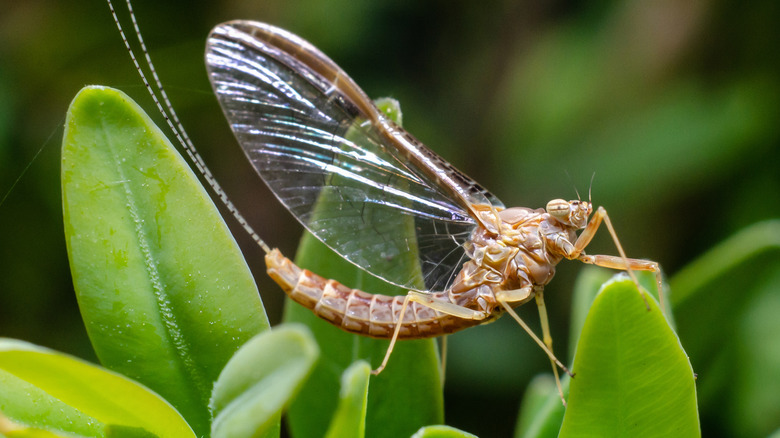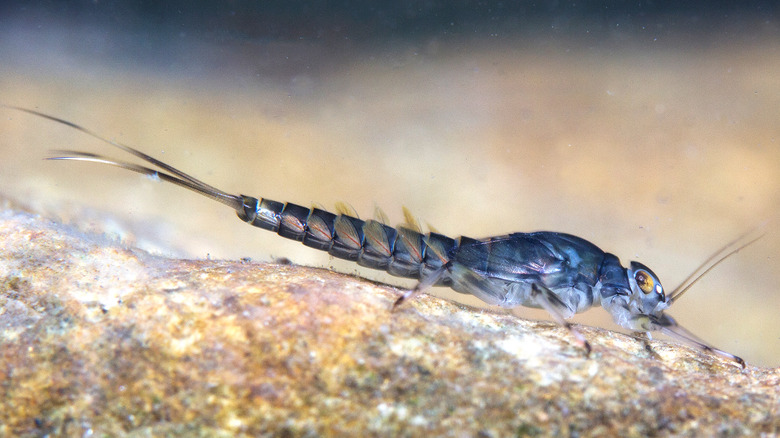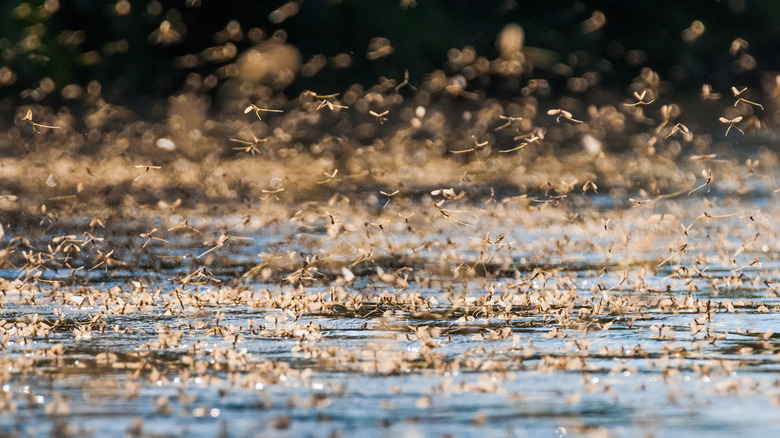Which Animal Only Lives For 5 Minutes As An Adult?
Mayflies are ancient, but their life is brief. A 312 million-year-old mayfly fossil is thought to be the oldest impression of a flying insect yet discovered, according to NBC News. That said, the adult mayfly's life span is among the shortest of all insects: 5 minutes, according to PBS. The insect's Latin name is Ephemeroptera, means "short-lived flyer."
The mayfly was mentioned in the ancient text "The Epic of Gilgamesh" (via Freshwater Blog) as a symbol for the brevity of human life: "Ever the river has risen and brought us the flood, the mayfly floating on the water. On the face of the sun its countenance gazes, then all of a sudden nothing is there."
There are about 2,500 species of mayflies in the world, according to Britannica, and the only continent not to sport the mayfly is Antarctica. According to the National Wildlife Federation, they live in gravelly streams and require clean water which makes them a good bioindicator — an organism whose presence is used to measure an environment's health.
Life begins underwater
The mayfly deposits its eggs on the water's surface which then sink to the bottom, according to Britannica. They hatch in about two weeks, unless conditions are not right for them to hatch. If this happens, the eggs go into "diapause," which is an adaptation that stops growth and delays hatching until conditions are better for the young mayfly nymphs to break free.
Mayfly nymphs have six legs, and gills to breathe underwater. Depending on the species of mayfly, the nymph stage will vary. Some species will stay in this juvenile stage for two years while some will whiz through it in two weeks. Nymphs eat algae, plants, and decaying organisms; and some species are carnivorous. Nymphs themselves are an important food source for fish. Growth is continuous throughout this stage, and mayfly nymphs can molt (i.e. shed their skin) as many as 50 times.
After outgrowing the nymph stage, the mayfly undergoes two-winged life stages. The first stage, called subimago, starts in the water. Once the subimago emerges from the water and dries its wings, the young insect flies off and rests in the bushes or trees near the stream, according to the Delaware River Guide. It is here that the final molt takes place, and the sexually-mature adult mayfly, called an imago, emerges.
Carpe diem
Adult mayflies have compound eyes and two sets of wings, according to Britannica. They have two or three tails that are at least as long as the body, which ranges from an eighth of an inch to just over an inch. Most uniquely, adult mayflies lack working mouthparts and digestive tracts, because they don't have time to eat. According to PBS, the adult stage of a female mayfly lasts less than five minutes. The males enjoy a longer adulthood, and in some species can live up to two days, according to Britannica. In any case, the final life stage of the mayfly is a dizzying whirlwind of reproduction and death.
After their final molt, males leave the trees to form a mating swarm: flying up, drifting downward, then repeating the dance, according to Craig Macadam of the Riverfly Partnership, writing for Freshwater Blog. Females enter the swarm, and the males grab them by the thorax using elongated legs. After mating in flight, the females drop to the water, lay their eggs, and die, providing food for fish.
The males die on land, sometimes in such large numbers that towns in North America use snowplows to remove mayfly carcasses from the road. In many countries, including China and Japan, mayflies are not seen as a nuisance; rather they are a popular and protein-rich seasonal food source, as explained in the 2001 research paper "Mayflies as Food."
Meanwhile, the mayfly's circle of life continues, as the eggs laid on the water drift downward to the gravelly bottom of the stream, to hatch later as nymphs.


